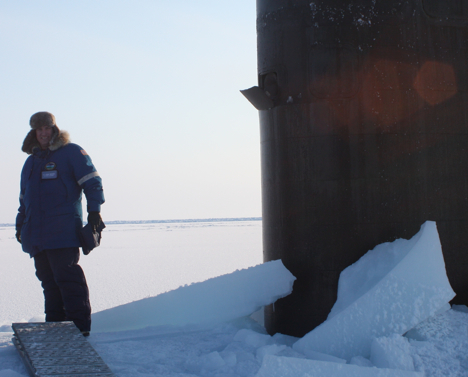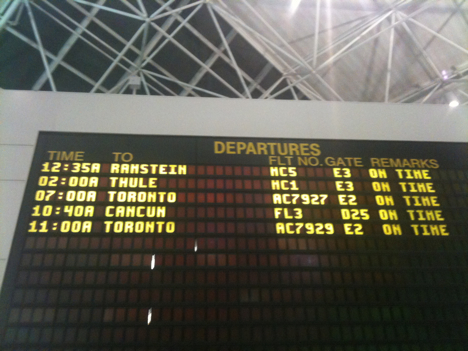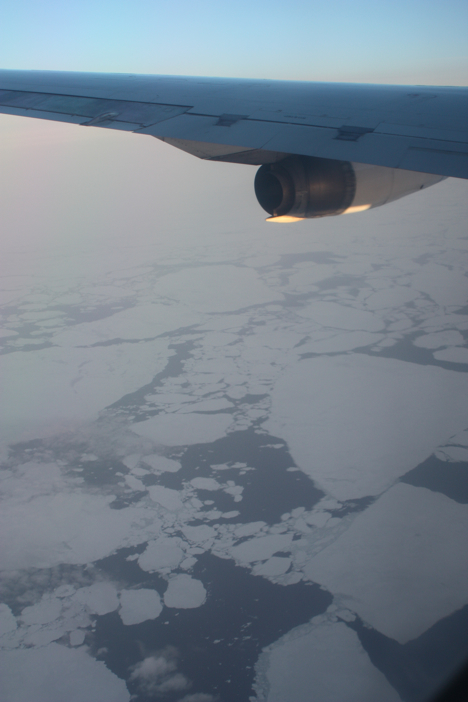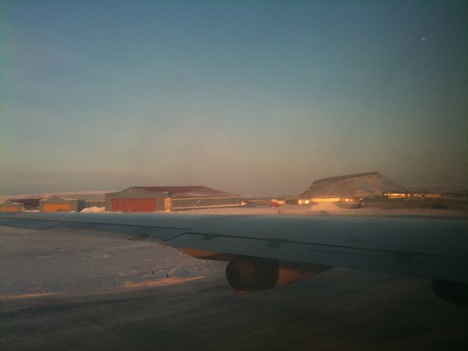March 10, 2011
LCDR John Woods is a Meteorology and Oceanography Officer (METOC) currently teaching in the Oceanography Department at the United States Naval Academy (USNA). He is part of the Sea Ice Thickness Observation team joined NASA’s Operation IceBridge mission in the field for the Arctic 2011 campaign. (OIB 2011).

LCDR John Woods stands on the USS Annapolis during ICEX 2009, 200 miles north of Alaska. Credit: LCDR Woods
Most midshipmen at USNA spend their spring breaks in some warm, tropical location. But I like to introduce students to an environment unknown to many, the Arctic. These next few weeks I will be living at Thule Air Force Base on the Northwest coast of Greenland, flying in NASA P-3 aircraft, observing the collection of data of Arctic Sea Ice. I have a senior research student along with me, who will be finishing up his project on looking at sea ice observation techniques with some “in-field” experience.
How did we get here? About two months ago, my attempts to participate in a Navy Ice Camp off the North Slope of Alaska, to which I brought two students in 2009, were not looking so promising, so I began looking for another mission to the Arctic. A good colleague of mine, Jackie Richter Menge, pointed me towards the Sea Ice Observing Team (of which she is the lead) meeting at NASA’s Goddard Space Flight Center right down the road from Annapolis, in Greenbelt, Md. I had never heard of IceBridge before this meeting, but left with the prospect that a student and myself would be able to participate in P-3 overflights of the Arctic. Well, after weeks of thorough coordination with multiple parties and agencies (Navy, NASA, NOAA), we found approval and funding for our trip.
MIDN Brugler is finishing up his USNA Senior Research project working with me on sea ice thickness measurement studies. He has been busy for two semesters reading papers and looking at data, but my goal was to get him into the field to observe the collection techniques he has spent so much time reading about. It was a big sacrifice to give up his final spring break, but I think he is excited about this once-in-a-lifetime experience.
So, our trip began at Baltimore Washington International Airport just a short 30 minute drive from my home. We piled our three children into the car, and my wife Anne drove Eric and I to the airport at 9 p.m. We showed up at the Military Airlift Command, to a fairly empty airport, and one of the easiest check-in process I have ever experienced traveling. We then searched out some food to wait for our 2 a.m. flight departure, and we ran into the rest of the party traveling to Thule with us. It was great linking up with the rest of the “first wave” of IceBridge team members. A majority of the team will be arriving via the P-3 aircraft next week on Monday. 2 a.m. arrived and we boarded the DC-8 chartered aircraft for the 5 hour and 45 minute flight due north to Greenland.

The departure flight board at BWI airport notes our 2 a.m. flight to Thule. Credit: LCDR Woods
The flight was comfortable, although a bit chilly at times. It was similar to a commercial airline, however, it was primarily a cargo mission, with most of the plane consisting of a large cargo hold and with only 30 seats situated towards the rear of the aircraft. I was able to sleep for some part of the flight (remember it was VERY early in the morning!) However, I was gratefully woken up by a strong beam of sunlight as the sun rose through the window across from me. This was a pleasant surprise, because as I looked out my window I saw a beautiful sight. Large sea ice floes creating a seascape like one I have never seen before. I began snapping pictures for the remainder of the flight. Each minute the area of ocean below us was constantly changing. It would be completely covered in ice, then only several floes. Large cracks or leads, different stages of ice formation, open water, icebergs, and even sea smoke (or low clouds) forming over the relatively warm ocean and VERY cold air above. It was truly breathtaking!

Large sea ice floes below are illuminated by the sunrise. Credit: LCDR Woods
We landed at approximately 9 a.m. local (a 1-hour time advance), to some more great scenery. Once the coastline of Greenland was spotted, we were already on final approach. This was another landscape that I have never experienced before. The Greenland Ice Sheet was directly below us, mountains went right to the ocean, glaciers flowing between peaks, ending in a field of broken up icebergs floating just offshore stuck in the ice. We were only over land for a few minutes before Thule Air Force Base was in sight. We rounded Mt. Dundas and landed smoothly on the white ice-covered runway. A short taxi to the terminal and we stepped out into the bone-chilling minus 25 degree weather. Instantly the moisture inside my nose froze. It was a very interesting feeling. Once inside the terminal, the base commander and his leadership team greeted us (as we were the only flight in for the week), and instantly made us feel at home. We are excited to explore the base and take in as much of the Thule experience while we have the opportunity before we get involved with the IceBridge flights scheduled to begin on Tuesday.

On the ground at Thule AFB, Mt. Dundas can be seen in the background, right-hand side. Credit: LCDR Woods
Tags: Arctic 2011




I am in awe of your research and mission and I look forward to any and all updates. Thank-you all for your service and best of luck and safety.
I have been to Thule twice to entertain the troops at the Air Force base.I was a guest vocalist with my friends in the Maria Rose band.It was an amazing place and an experience that I will never forget.Thanks for sharing and bringing back some memories
Thank you, this is amazing.. My brother was stationed in Greenland for sometime..
Let’s have some more!!!
Muito bom, parabens por esta sua sorte em viajar por lugares tão distantes e lindos. E a aurora boreal linda. Abraço
This is amazing. I have never heard of Icebridge before and I am always searching for info on the Arctic or Antarctica. I cannot wait to share this with my 3rd graders tomorrow. I have signed up for updates to follow your research. Best wishes.
Great bunch of accounts and pictures. Thank You.
NASA The BEAUTIFUL, wow!!! God bless YOU, God bless all Your Space & World Men who explore for all us! Dreaming Mars Red Planet, remembering Spirit & Opportunity, my beloved martian rovers, I think to all Men & Women of NASA & of U.S. Naval Accademy & I pray for all YOU a most long life in good health in the name of Human Civilization. Evolution called NASA, in my mind. Thanks my beloved American Brave People! You remind me every day the HOPE & the JOY of the FUTURE wich YOU are building. There are not enough of words for thank Your HARD INTREPID WORK. Human People must find the MONEY for NASA. So & forever, in my mind it’s the REAL SOLIDARIETY! Thanks&Love for eternity:)
Hey, your blog is sooo interesting, please keep it up with the pictures…Thanks…Georgie from UK….Travelling in New Zealand.